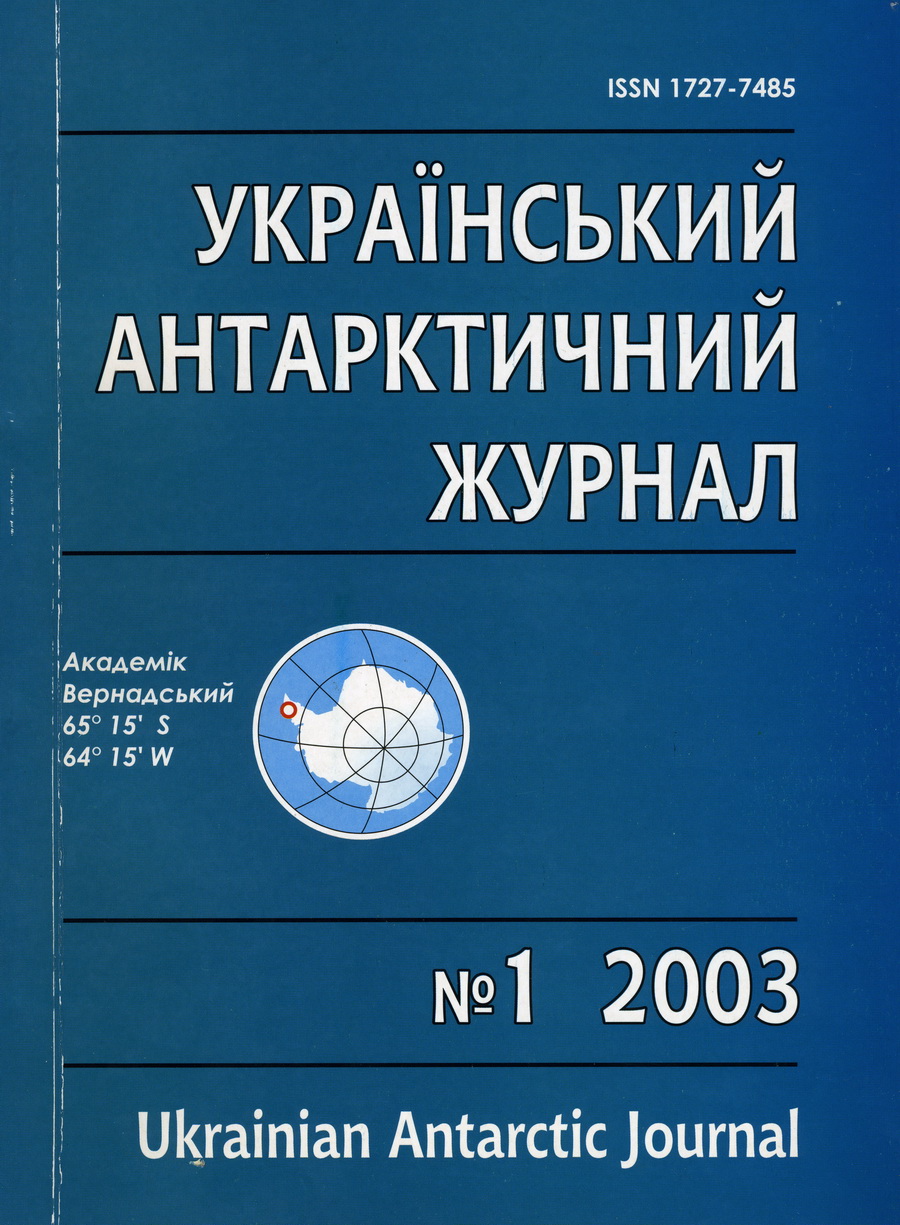Стан мікропланктонного угрупування (фіто- і бактеріопланктон) в осінній період на мілинах Аргентинських островів, Антарктика
Анотація
Біомаса та продукція бактеріо- і фітопланктону вимірювались в районі Української антарктичної станції (УАС) Академік Вернадський в кінці березня 1998 р. В складі “осіннього” фітопланктону архіпелагу Аргентинських островів було визначено 70 таксонів планктонних водоростей. По біомасі домінували діатомові, передусім, Corethron criophylum. На половині станцій чисельно переважали флагеляти; масовими були діатомові водорості (Chaetoceros, Corethron, Fragilariopsis), та на деяких станціях, кокколітофоріди (Сoccolitina sp.). Виміряна первинна продукція в поверхневому шарі води в середньому складала 9,66 ± 6,87 мг C м-3 доб-1 (від 3,0 до 15,86), а розрахована – 7,55 ± 2,61 мг C м-3 сут-1 (від 1,14 до 12,61). Середня чисельність бактеріопланктону знаходилась на рівні 0,5 млн. кл. мл-1. Продукція бактерій в поверхневому шарі складала в середньому 52% від рівня продукції фітопланктону.
Посилання
- Bondar', S.B., & Orlova, I.G. (1998). K voprosu ob organizacii i otdel'nye rezul'taty kompleksnogo ekologicheskogo monitoringa v raione antarkticheskoi stancii Akademik Vernadskii [To the problem of organisation of, and selected results obtained in, comprehensive ecological monitoring in the region of the Antarctic station Akademik Vernadskiy]. Bulleten UAC, 2, 160-170. (In Russian)
- Brianceva, Yu.V. (1996). K metodike rascheta obyoma kletok fitoplanktona [To the method of calculation of the volume of phytoplankton cells]. Trudy YugNIRO, 42, 195-199. (In Russian)
- Ivanov, A.I., & Minicheva, G.G. (1998). Planktonnyie i bentosnyie vodorosli raiona ukrainskoi antarkticheskoi stancii Akademik Vernadskiy [Plankton and benthos algae of the region of the Ukrainian Antarctic Station Akademik Vernadsky]. Bulleten UAC, 2, 198-203. (In Russian)
- Rat'kova, T.N. Raspredeleniie fitoplanktona v Avstralo-novozelandskom sektore Antarktiki v ianvare-fevrale 1976 i 1983 [The distribution of phytoplankton in the Australo-New Zeland sector of Antarctica in January-February 1976 and 1983]. Biologiia okeana, tez. dokl. III cyezda sovietskih okeanologov. Leningrad, 14-19 December 1987. Leningrad, Gidrometeoizdat. pp. 53-55. (In Russian)
- Hailov, K.M. et al. (1992). Funkcional'naia morfologiia morskih mnogokletochnyh vodorosley [Functional morphology of sea many-cell algae]. Kyiv, Naukova dumka. 280 p. (In Russian)
- Chmyr, V.D., & Seregin, S.A. (2002). Produkcia bakterioplanktona v vodah Antarktiki v marte - aprele 1998 g. [Production of bacterioplankton in the Antarctic waters in March - April 1998]. Bulleten UAC, 3, 110-114. (In Russian)
- Aristegui, J., Montero, M.F., Ballesteros, S. et al. (1996). Planktonic primary production and microbial respiration measured by 14C assimilation and dissolved oxygen changes in coastal waters of the Antarctic Peninsula during austral summer: implications for carbon flux studies. MEPS, 132, 191-201.
- Basterretxea, G., & Aristegui, J. (1999). Phytoplankton biomass and production during late austral spring (1991) and summer (1993) in the Bransfield Strait. Polar Biology, 21, 11-22.
- Bj∅rnsen, P.K., & Kuparinen, J. (1991). Determination of bacterioplankton biomass, net production and growth efficiency in the Southern Ocean. Mar. Ecol. Prog. Ser., 71, 185-194.
- Bird, D.F., & Karl, D.M. (1999). Uncoupling of bacteria and phytoplankton during the austral spring bloom in Gerlache Strait, Antarctic Peninsua. Aquat. Microb. Ecol., 19, 13-27.
- Daneri, G., Iriarte, A., Garcia, V.M. et al. (1992). Growth irradiance as a factor controlling the dark respirations of marine phytoplankton. J. Mar. Biol. Ass. UK, 72, 723-726.
- Fuhrman, J.A., & Azam, F. (1980). Bacterioplankton secondary production estimates for coastal waters of British Columbia, Antarctica and California. Appl. Environ. Microbiol., 39, 1085-1095.
- Holm-Hansen, O., & Mitchell, B.G. (1991). Spatial and temporal distribution of phytoplankton and primary production in the western Bransfield Strait region. Deep Sea Res., 38, 961-980.
- Huntley, M., Karl, D.M., Niiler, P. et al. (1991). Research on Antarctic Coastal Ecosystem Rates (RACER): an interdisciplinary field experiment. Deep Sea Res., 38, 911-941.
- Karl, D.M., Holm-Hansen, O., Taylor, G.T. et al. (1991). Microbial biomass and productivity in the western Bransfield Strait, Antarctica, during the 1986-87 austral winter. Deep Sea Res., 38, 1029-1055.
- Kopczynska, E.E. (1996). Annual study of phytoplankton in Admiralty Bay, King George Island, Antarctica. Polish Polar Research, 17(3-4), 151-164.
- Kottmeier, S.T., & Sullivan, C.W. (1987). Late winter primary production and bacterial production in sea ice and seawater west of the Antarctic Peninsula. Mar. Ecol. Prog. Ser., 36(3), 287-298.
- Menden-Deuer, S., & Lessard, E.J. (2000). Carbon to volume relationship for dinoflagellates, diatoms, and protist plankton. Limnol. Oceanogr., 45(3), 569-579.
- Moline, M.A., & Pruzelin, B.B. (1996). High-resolution time-series data for 1991/1992 primary production and related parameters at a Palmer LTER coastal site: implications for modeling carbon fixation in the Southern Ocean. Polar Biology, 17(1), 39-53.
- Montagnes, D.J.S., & Franklin, D.J. (2001). Effect of temperature on diatom volume, growth rate, and carbon and nitrogen content: Reconsidering some paradigms. Limnol. Oceanogr., 46(8), 2008-2001.
- Steemann Nielsen, E. (1952). The use of radio-active carbon (14C) for measuring organic production in the sea. Journ. du Conseil, 18, 117-140.

